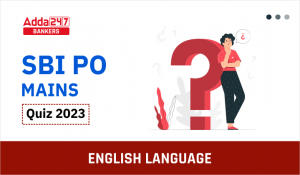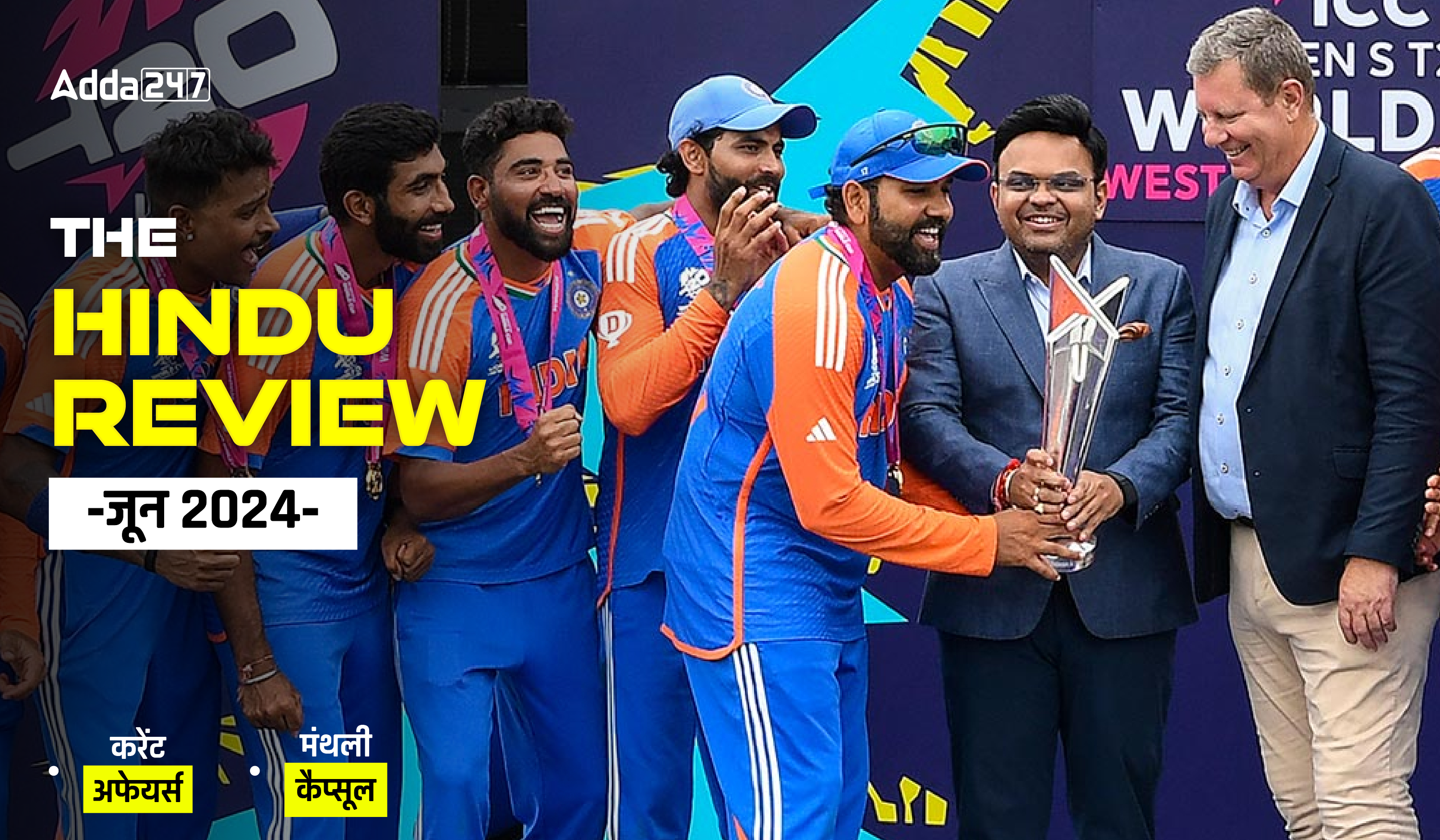
Directions (1-5): The following question consists of a sentence
which is divided into three parts which contain grammatical errors in one or
more than one part of the sentence, as specified in bold in each part. If there
is an error in any part of the sentence, find the correct alternatives to
replace those parts from the three options given below each question to make
the sentence grammatically correct. If the given sentence is grammatically
correct or does not require any correction, choose (e), i.e., “No correction
required” as your answer.
Q1. For many decades, the Indian policy framework facilitated the interaction of (I)/ science and
innovation with entrepreneurship, that
is leading for competition and (II)/ the subsequent development of an
industry structure that delivered
sustainable economic(III)/ benefits.
(I) framework facilitates
interaction among
(II) which led to competition and
(III) who delivered sustainable economic
(a) Only (I)
(b) Only (III)
(c) Both (I) and (III)
(d) Only (II)
(e) No correction required
Q2. The Reserve Bank of India (RBI) have come under a lot of fire in recent(I)/ months for its interest
rate decisions. Critics went to town claiming it was seeing imaginary inflation pressures in(II)/ the economy.
These attacks turned severe when the consumer price data for June was released.
The sharpen acceleration in inflation
since than(III)/ shows the critics were wrong.
(I) has come under a lot of
fire in recent
(II) it is seen imaginary
inflation pressures in
(III) The sharp acceleration in inflation since then
(a) Only (I)
(b) Only (III)
(c) Both (I) and (III)
(d) Both (II) and (III)
(e) No correction required
Q3. Education systems in
many countries are not performing up to expectation and many families has been turning towards (I)/
private schools since they feel that the
later deliver better education(II)/, especially when public schooling
itself is not fully free. India too fails to
provide free secondary public education (III)/
(I) families have been turning to
(II) the latter deliver better education
(III) at provided free secondary public education
(a) Only (I)
(b) Only (III)
(c) Only (II)
(d) Both (I) and (II)
(e) No correction required
Q4. India has taken some steps
in the direction of developing regulatory(I)/ frameworks for private
schools, with several states enacting
fee-regulation(II)/ legislation and the courts intervening to challenge private sector failures. (III)/
(I) steps for the direction of developed regulatory
(II) with several states enacted fee-regulation
(III) intervening to challenges encountered in private sector failures
(a) Only (I)
(b) Only (III)
(c) Both (I) and (III)
(d) Both (II) and (III)
(e) No correction required
Q5. Various Indian governments have long argued that international credit ratings agencies discriminate for
emerged market in(I)/ general and India in particular. The last Economic
Survey of India, the official document released at the time of the Union government’s
annual budget early in the year, devoted
an entire box to this complaint. (II)/ The government’s arguments were
persuasive: “India has a strong growth trajectory, which coupled with its
commitment to fiscal discipline exhibits
over the last three years of suggestions that its deficit(III)/ and debt
ratios are likely to decline significantly over the coming years.”
(I) credit ratings agencies discriminate against emerging markets in
(II) devoted a entire box to this complaint.
(III) exhibited over the last three years suggests that its deficit
(a)Only (I)
(b)Only (III)
(c)Both (I) and (III)
(d)Both (II) and (III)
(e)No correction required
Directions (6-10): In the question given
below, there is an error in one or more sentences. Please select the most
appropriate option, out of the five options given for each of the following
sentences, which, in your view, is grammatically or structurally
incorrect.
Q6. Burn
I. The children burned the
house down while playing with matches.
II. He burnt up the files.
III.The papers were burned up in the fire.
(a) Only I
(b) Only (II) and (I)
(c) Only III
(d) Only II
(e) All are correct
Q7. Wait
I. Each waitress
waits on three different tables in the restaurant.
II. Don’t wait up.
III. Let’s wait down for Mary to see how her date went.
(a)Only I
(b) Only (II) and (I)
(c) Only III
(d) Only II
(e) All are correct
Q8. Turn
I. My keys turned away in the bedroom.
II. They turned the wallet over to the police
III.They turned us away at the border because we didn’t have
visas.
(a) Only I
(b) Only (II) and (I)
(c) Only III
(d) Only II
(e) All are correct
Q9. Stand
I. SCUBA stands for “self-contained underwater
breathing apparatus.”
II. Soledad is so beautiful! She really stands for in a crowd.
III.I need you to stand up for and answer the phone when my broker
calls.
(a) Only I
(b) Only (II) and (III)
(c) Only III
(d) Only II
(e) All are correct
Q10. Put
I. I thought Ms. Smith put her ideas down rather clearly in
the meeting.
II. I told you kids to put your toys away.
III.She always puts down people who don’t share her opinions.
(a) Only I
(b) Only (II) and (I)
(c) Only III
(d) Only II
(e) All are correct
Directions (11-15):
The following question consists of a passage in which certain
phrase/Sentences are printed in bold. Find out if there is an error in
any of the bold part of the sentence, find the correct alternatives to replace
those parts from the three options given below each question to make the
sentence grammatically correct. If the given sentence is grammatically correct
or does not require any correction, choose (e), i.e., “No correction required”
as your answer.
Free and compulsory education of children in
the 6 to 14 age group in India (11) become a fundamental
right when, in 2002, Article 21-A was inserted in the 86th Amendment
to the Constitution. This right was to be governed by law, as the state may
determine, and the enforcing legislation for this came eight years later, as
the Right of Children to Free and Compulsory Education (RTE) Act, 2010, or the
RTE Act.
(12) With
examples from all around hundred countries which having various and
similar pieces of legislation or regulations already in place, there were
practices drawn from similar experiences. (13) Since its enactment, the
RTE Act has been lauded and disparaged. But there has been a concern
not only over its provisions but also about the lacunae in the school education
system. However, there are clauses in the Act (14) which
has enormous catalytic potential but it have gone largely untouched
and unnoticed. A focus on three of these provisions can result in an immediate
and discernible impact.
The RTE Act is a game-changer in that it
establishes that the onus to ensure free and compulsory education lies on the
state. (15) However, the ‘compulsory’ and ‘state liability’
part needs to be imbibed by the educational bureaucracy, which is now
lacking.
Q11.
I. Will become a fundamental right
II. became a fundamental right
III. have became a fundamental right
(a) Only I
(b) Only II
(c) Only III
(d) Only I and II
(e) No correction required
Q12.
I. having examples from over a hundred
countries having various
II. With examples over a hundred of the
countries having a various
III. With examples from over a hundred
countries having various
(a) Only I
(b) Only II
(c) Only III
(d) Only I and II
(e) No correction required
Q13.
I. Since its enactment, the RTE Act been
lauded and
II. Since their enactment, the RTE Act have
been lauded and
III. Since its enactment, the RTE Act will
been lauded and
(a) Only I
(b) Only II
(c) Only III
(d) Only I and II
(e) No correction required
Q14.
I. which had enormous catalytic potential
though it
II. which must be having enormous catalytic
potential but should
III. which have enormous catalytic potential
but that
(a) Only I
(b) Only II
(c) Only III
(d) Only I and II
(e) No correction required
Q15.
I. However, the ‘compulsory’ and ‘state
liability’ part needs for be imbibe by the educational bureaucracy, which is
II. However, the ‘compulsory’ and ‘state
liability’ part needed to be imbibed by the educational bureaucracy, which is
then
III. Though, the ‘compulsory’ and ‘state
liability’ are the part needs to be imbibed by the educational bureaucracy,
which are in turn
(a) Only I
(b) Only II
(c) Only III
(d) Only I and II
(e) No correction required
Solutions
S1. Ans.(d)
Sol. There is an error in II part of the
sentence. “that is leading……” is incorrect use , as the sentence
is in past tense. Replace it with II statement given in option.
S2. Ans.(c)
Sol. There are errors in parts I and III
of the sentence. RBI is a single body organization, hence, “HAS”
should be used.
Similarly, in part III of the sentence,
use of “than” is incorrect here. Then is mainly an adverb, often used
to situate actions in time. For example, you wake up in the morning and then
have breakfast. It’s also used in if … then constructions such as, “If you wake
late, then you might have to skip breakfast.”
Than is a conjunction used mainly in
making comparisons—e.g., “My breakfast is better than yours”; “I make breakfast
differently than you do.”
S3. Ans.(d)
Sol. There are errors in I and II part
of the sentence. In I replace “has” with “have”.
In II Use of “Later” is
incorrect.
Later- happening at a time subsequent to
a reference time.
Latter- referring to the second of two
things or persons mentioned (or the last one or ones of several)
S4. Ans.(e)
Sol. No correction required
S5. Ans.(c)
Sol. There is an error in part I of the
sentence. “discriminate against” should be used in place of
“discriminate for”.
Where as in part III, use
“exhibited” in place of “exhibits”.
S6. Ans.(e)
Sol. burn down – destroy by setting fire
to
burn down- burn until completely gone
(building)
burn up -consume by fire
S7. Ans.(c)
Sol. Let’s wait up for Mary to see how
her date went.
wait on – serve, service (a table)
wait up- not sleep because you are
waiting for something or someone
wait up for- not sleep because you are
waiting for someone or something
S8. Ans.(a)
Sol. My keys turned up in the bedroom.
turn away- refuse to deal with or give service
turn over – give to authorities (said of
evidence or stolen / lost property)
turn up – find unexpectedly
S9. Ans.(b)
Sol. Soledad is so beautiful! She really
stands “out” in a crowd.
I need you to stand ‘by’ and answer the
phone when my broker calls.
stand by – wait
stand up- not arrive to a date or an
appointment (inf.)
stand up for – defend (something one
believes in)
stand for – represent
stand for – tolerate
S10. Ans.(a)
Sol. I thought Ms. Smith put her ideas
across rather clearly in the meeting.
put away – return to the proper place of
storage
put across – communicate (an idea or
suggestion) clearly so that it is understood
put down -insult, say bad things about
put in -officially submit a request (in
the armed forces or public services)
S11. Ans.(b)
Sol. Option B is the appropriate choice.
Past Indefinite tense is required here; For this reason other options can be
eliminated easily.
S12. Ans.(c)
Sol. Option C is the most appropriate
choice here. Other options can be ruled out as they are grammatically
incorrect.
S13. Ans.(e)
Sol. No correction required
S14. Ans.(c)
Sol. Option C is the most appropriate
choice here. Plural verb “have” is the correct usage.
S15. Ans.(e)
Sol. No correction required

 English Quizzes For SBI PO Mains 2023 - ...
English Quizzes For SBI PO Mains 2023 - ...

